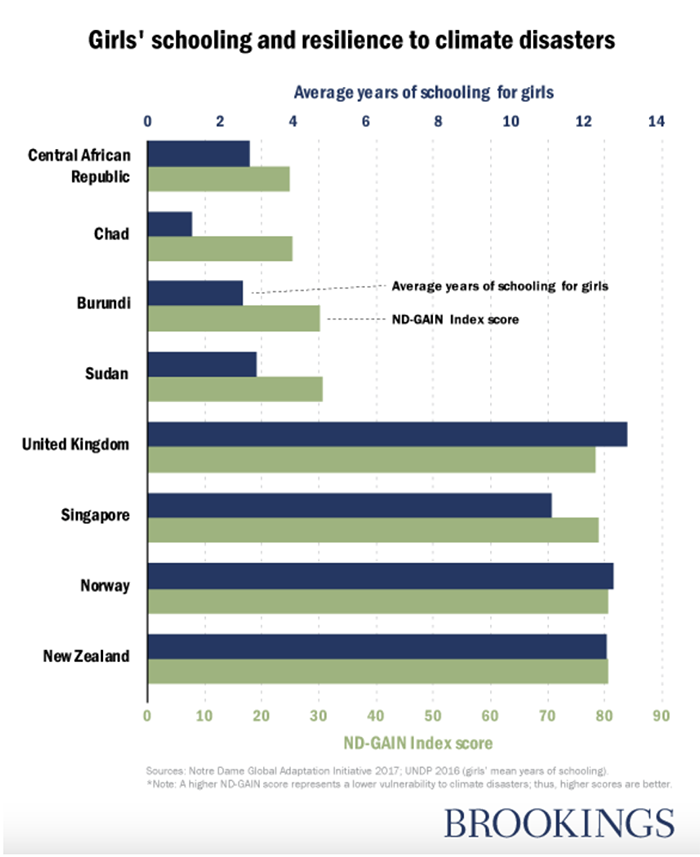By Carsyn Baxter, Lydia Kiros, and Mariana Felix Angioletti
The effects of climate change hinder access to education for millions with extreme weather events resulting in destroyed educational materials and infrastructure, climate-driven displacement, and linguistic barriers in new communities. Without access to education, vulnerable populations can experience exacerbated levels of poverty, hunger, and overreliance on climate-sensitive sectors such as agriculture. In addition to external shocks, gender inequality imposes barriers to education on women and girls at the center of the climate crisis.
SDG target 4.5 asserts that the international community must “eliminate gender disparities in education and ensure equal access to all levels of education and vocational training for the vulnerable, including persons with disabilities, indigenous peoples and children in vulnerable situations.” We present how climate-smart and gender-responsive education systems can help achieve this goal and build resilience among the most vulnerable populations.
Access to quality education can improve the resilience of communities to respond to climate-related shocks. A 2022 report from the Global Center on Adaptation demonstrates that by improving educational outcomes for children, climate risks could be reduced for 275 million people worldwide. The Notre Dame Global Adaptation Initiative Index shows a relationship between improved secondary/higher education access and improved resilience to climate disasters for each additional year of schooling that girls acquire.
A climate-smart education system utilizes a multifaceted approach that “encompasses the broader goals of advancing equitable quality education, protecting the planet’s life systems and promoting climate justice.” In order to achieve climate-smart education, focus must be on meeting the minimum proficiency levels of the SDGs, educating individuals on the threats of climate change, and strengthening three key responses to the climate crisis – mitigation, adaption, and resilience building.
First, regarding mitigation, girls are more likely to have the skills to withstand and overcome shocks that arise from extreme weather events when they have received 12 years of quality education. Literacy, numeracy, critical thinking, and problem-solving skills contribute to girls’ abilities to help families better process and act on information about risk, such as weather reports.
Research also shows that countries that invest in girls’ education suffer fewer economic losses from extreme weather events than their counterparts with equivalent income and weather conditions. Income and girls’ education are significant variables in determining vulnerability to extreme weather events, and countries’ future resilience will likely increase with economic growth and improvements in education.

Second, educated women and girls better adapt to the worst effects of climate change, which helps to reduce poverty, hunger, and improve economic outcomes for their communities. In a 2023 article, the UNFCCC explains that “when provided with the same access to resources as men, women can increase their agricultural yields by 20 to 30%,” in response to land degradation caused by climate change.
Finally, when education empowers girls to lead, participate, and make decisions, they enact pro-environmental and resilient policies for their communities. In a study of 130 countries between 1980 and 2010, the Brookings Institution reports that reduction in vulnerability to natural disasters was associated strongly with women and girls’ education and that it “is the single most important social and economic factor… even when controlling for many other aspects of human development like income and life expectancy.” A 2019 study of 91 countries shows that countries with higher proportions of women’s representation in national legislatures have more stringent climate change policies that result in lower carbon dioxide (CO2) emissions.
A climate-smart and gender-responsive education system advances equitable, quality education and plays a crucial role in building climate resilience for vulnerable populations. Promoting girls’ education is a sustainable pathway to enhance global resilience to climate change. Synergies between efforts to achieve the Global Goals on education, gender equality, and climate change play an active role in shaping a resilient and sustainable future for all.
* * *
Carsyn Baxter, Lydia Kiros, and Mariana Felix Angioletti are MA students, International Development Studies, George Washington University.